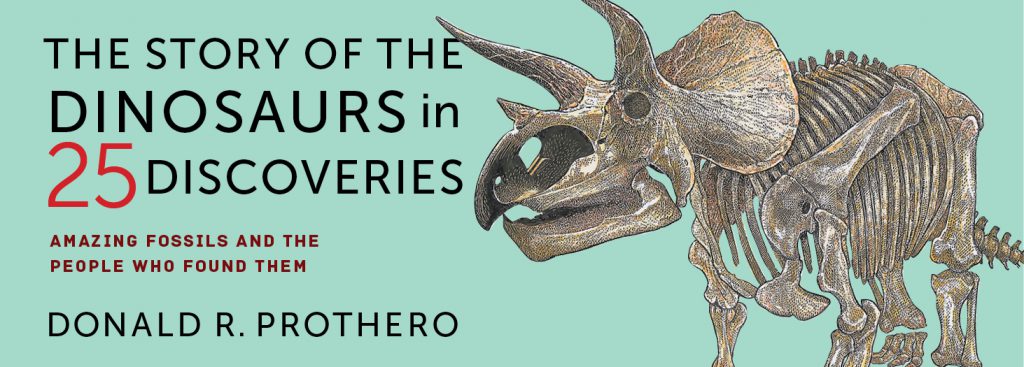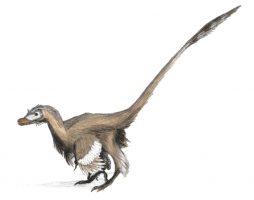Seven Extraordinary Facts About Dinosaurs

“This book is excellent. Rather than simply a profile of twenty-five dinosaurs, it puts each of these in context of its discovery and significance in terms of the science of paleontology, as well as comparisons with close relations. Thus, it covers hundreds of dinosaurs, not just twenty-five.”
~ Thomas R. Holtz Jr., University of Maryland
Ever since we first began to uncover fossils in the 1800s, humans have been enamored with the legend of dinosaurs. There are movies and shows about them, museum exhibitions dedicated to their history, even toys and clothes for children bearing their striking, scaly likeness. But just how accurate is our knowledge about these creatures of the past? CUP author Donald Prothero, a professor of geological sciences at California State Polytechnic University in Pomona, is sharing some of his favorite facts about dinosaurs which are sure to make you view these beasts —and even birds— in a new light. Prothero’s new book is now available, The Story of the Dinosaur in 25 Discoveries: Amazing Fossils and the People Who Found Them.
Enter our drawing for a chance to be one of the first to own a copy of the book!
• • • • • •

1. Just because it is extinct doesn’t make it a dinosaur.
Those kits full of plastic toy “dinosaurs” usually contain a lot of non-dinosaurs, including saber-toothed cats and mammoths (which are mammals), the fin-back Dimetrodon (a mammal relative), and others. Dinosaurs are defined by a very specific set of anatomical features they all share, not whether they’re prehistoric or whether they’re extinct.
2. There were no dinosaurs in the ocean, nor were the flying pterosaurs members of the Dinosauria either.
The marine reptiles, such as the paddling plesiosaurs, the dolphin-like ichthyosaurs, or the too-large mosasaur in the first Jurassic World movie are indeed reptiles but not closely related to dinosaurs. The fearsome-looking pterosaurs that dominated the Jurassic and Cretaceous skies are close relatives of dinosaurs, but not within the group Dinosauria.
3. Dinosaurs all had feathers.
Since 1996, we have known that all dinosaurs had feathers, at least they did when they were small and young. The biggest adult dinosaurs may have lost their feathers because they didn’t need the insulation. In 2018, we found out that pterosaurs were covered in feathers, too. Feathers evolved for insulation, not for flight. Sadly, the Jurassic Park/World movies haven’t kept up with the science and insist on showing naked dinosaurs, even though they have been told again and again that this is wrong.
4. Most of the stuff you see about dinosaurs on TV or movies is made up.
With a few minor exceptions, we have no evidence of what color dinosaurs were, what they sounded like, or how they behaved. A few feathered dinosaur fossils are now known to have preserved pigment cells that show their color patterns, but most colors you see on dinosaur reconstructions are pure guesswork by the artists. We know from trackways a bit about how dinosaurs moved and how they laid eggs and took care of them, but the rest is complete fiction.
5. Velociraptor was the size of a turkey.
Author Michael Crichton, who wrote the original Jurassic Park books, got Velociraptor mixed up with a much larger dinosaur called Deinonychus, which really was the size of the “Velociraptors” in the movies. On the other hand, the “spitting” Dilophosaurus in the movies was too small. It was only half as big as the real fossil, did not spit venom, and did not have a frill around its neck. The terrifying Spinosaurus that kills a T. rex in Jurassic Park III was much smaller in real life, and built like a crocodile, swimming in the water with webbed feet. Movies are fiction, not science.
6. Cloning dinosaurs will never happen.
DNA breaks down immediately after death, so it is some parts are unreadable after a few centuries. Even the best-preserved frozen mammoths from the Siberian permafrost, which are only 10,000 years old and still edible, have such degraded DNA that cloning a mammoth with an elephant mother will never happen. Never mind trying to read DNA that has been around for 66 million years or longer and has been digested in the gut of a mosquito (insects preserved in amber have no original tissue, either).

7. Dinosaurs are not extinct—they are flying outside your window right now.
Birds are descended from the same branch of dinosaurs that included Velociraptor. They have dozens of unique anatomical features that prove this. So dinosaurs did not vanish at the end of the Cretaceous—they have been evolving and thriving for another 66 million years!





